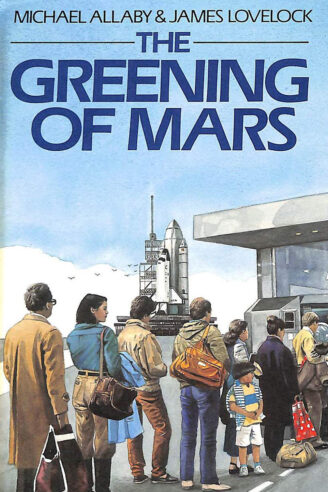Mars has called to generations of space enthusiasts, a crimson fleece for would-be astronauts. Visions of how we might or might have gone there have become a staple of speculative fiction, especially in the post-Apollo era, as things such as Stephen Baxter’s Voyage can attest. But in 1984, Gia hypothesis creator James Lovelock and science writer Michael Allaby presented The Greening of Mars, a Martian shape of things to come which arrived almost a decade before Kim Stanley Robinson offered his vision of the red planet transformed.
As a work of future history overtaken by reality, it is also alternate history. For what Lovelock and Allaby’s slim book (the edition I read in 2019 ran a mere 166 pages) does is present a brief history of Martian colonization that began in the 1980s and runs someway into the future. Its driving force is Sir Travers Foxe, someone not unlike an Elon Musk for the Boomer generation, an entrepreneur who, using former nuclear missiles and CFC carrying machinery, starts the process of change on Mars.
As that description might suggest, the near-future that Lovelock and Allaby foresaw was optimistic. They envisaged the Cold War, for example, ending both early and with borderline nuclear disarmament, creating a situation that left thousands of missiles sitting around for someone to dispose of for various governments.
The disposal of CFC production machinery and items came closer to passing, but not on the grand scale they imagined. Perhaps, if someone like Musk had shown up a couple of decades earlier, it might have, though.
The first portion of the narrative ends with a manned Soviet flyby of Mars before the extent of Foxe’s plans become clear, also expecting a voyage that wasn’t to be thanks in no small part to the very end of the Cold War they had anticipated.
And it’s here that this slim book becomes frustrating. The Greening of Mars owes more than a passing debt to H.G. Wells’ The Shape of Things to Come, which it resembles in more ways than one. Namely, it’s a “future history”, told from the perspective of a future Mars-based human on the return journey from Earth, as our unnamed narrator takes the reader on a journey through the history of the Mars colony and the science behind it. Not terraforming, as became the vogue in the 1990s, but of comparatively small but highly significant changes to the formerly red planet, the “greening” of the title.
Grounded firmly in real science, it’s a future history heavy in ideas but lacking anything a reader can firmly catch onto, such as characters and events.
That choice is an interesting one as, like Wells before them, it feels that the authors’ idea was to be authentic in offering something that could well come to pass. Instead, that rooting leaves it feeling like a science textbook much of the time.
What it wants to be, so clearly, is an ahead-of-its-time mashup of science-fiction novel and popular science. Even more so when it goes on for pages at a time about chemical processes, how solar sails work and so forth.
True, there are lots of intriguing details, from how the greened Martian air affects vocal ranges to vegetarian diets due to issues bringing animals across interplanetary space, and the entire final chapter, yet all are guilty of breaking that old maxim that one should show, not tell. It’s something that leaves the book feeling clinical and dense despite the relatively short page count.
That might sum up The Greening of Mars rather neatly. There are many fascinating ideas presented by Lovelock and Allaby in their vision of how not to terraform the red planet but make it friendlier for humanity, something which makes it stand out from later Mars-themed works. For all its faults, and there are plenty, it’s both not difficult to see why it’s fallen by the wayside, but also why it deserves a second look.
This story was originally published by Sea Lion Press, the world’s first publishing house dedicated to alternate history.





